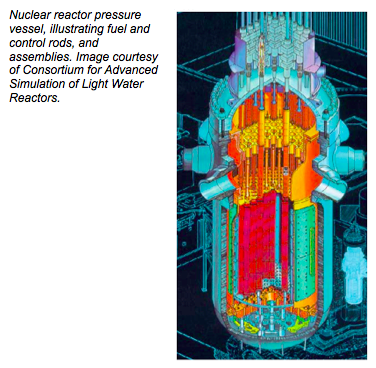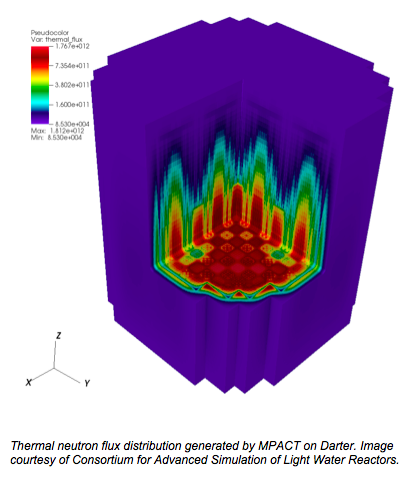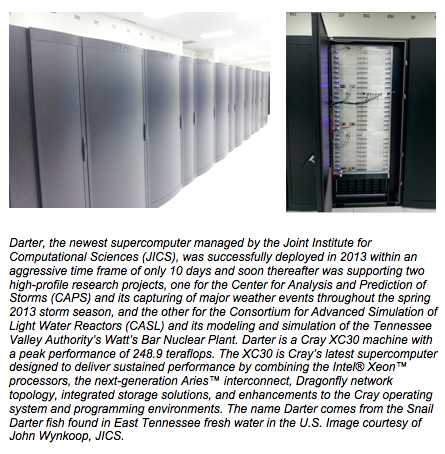JICS Helps Consortium Meet Critical Nuclear Validation Milestone
The Consortium for Advanced Simulation of Light Water Reactors (CASL) last year was in dire need of high-performance computing support. In supplying that essential missing element, Joint Institute for Computational Sciences (JICS) leadership, its staff, and the JICS-managed Cray XC30 Darter supercomputer, assisted CASL in successfully completing one of the most significant milestones it has delivered, simulation of the Watts Bar Unit 1 zero-power physics test. The zero-power physics tests are performed at the start of each fuel cycle, before escalating power and placing the unit on the electric grid.
 CASL performs modeling and simulation (M&S) on supercomputers to enhance researchers' understanding of reactor performance so that power output can be increased, reactor life extended, and waste reduced. Using M&S, CASL created the Virtual Environment for Reactor Applications (VERA) program, which allows for predictive simulation of light water reactors.
CASL performs modeling and simulation (M&S) on supercomputers to enhance researchers' understanding of reactor performance so that power output can be increased, reactor life extended, and waste reduced. Using M&S, CASL created the Virtual Environment for Reactor Applications (VERA) program, which allows for predictive simulation of light water reactors.
Since its inception in 2010, CASL has relied on a range of computational resources, from development and testing systems with a few dozen processor cores to some of the largest computer systems in the world, housed at Oak Ridge Leadership Computing Facility—first the Cray Jaguar system and most recently the NVIDIA GPU-accelerated Cray XK7 system known as Titan. In the spring of 2013, however, CASL was faced with a challenge.
As the critically important Watts Bar milestone loomed, Jaguar was in the final stages of being upgraded to become Titan and would not be available to provide support. So CASL leadership approached JICS for help, and, fortunately, JICS was in the process of deploying Darter; acceptance testing was complete, and the system was being used in limited fashion in preparation for full production use. JICS leadership and staff responded positively, providing outstanding support, according to CASL scientist John Turner of Oak Ridge National Laboratory (ORNL). Within a few days, accounts were being created, and CASL staff was able to begin developing and scoping on Darter, he said.
Turner explained that some of the heaviest use of Darter for CASL was as a development platform for a physics component known as MPACT, being created primarily by staff and students at the University of Michigan. MPACT is one of two components being developed to simulate the behavior of neutrons within reactor cores. Because neutrons drive the reactions at the heart of the process within a reactor core that generates heat, and ultimately electricity, accurate simulation of their behavior is essential. MPACT simulates neutron behavior in both 2D and 3D geometries. MPACT also performed multiple simulations that used more than 3,000 process cores for about 3.5 hours.


"It should also be noted that the value of Darter to CASL went beyond merely the delivery of computational cycles," Turner stated in a CASL project report. "First, it provided a different software environment for VERA, and each additional platform provides an opportunity to improve VERA's portability. Second, Darter provided a new and unique hardware configuration for VERA, being the first Intel-based Cray system CASL had used, as well as the first to use the Ares interconnect technology."
According to a news release from ORNL, the results from CASL's milestone simulation from VERA were compared with actual data provided by the Tennessee Valley Authority's (TVA) Watts Bar Nuclear Plant, Spring City, Tenn., which confirmed its accuracy. Information provided in the news release states that CASL, headquartered at ORNL, is one of the U.S. Department of Energy's Innovation Hubs. CASL brings together industry, academia, and national laboratories to provide advanced M&S solutions for commercial reactors. Its mission is to confidently predict the performance of nuclear reactors through comprehensive science-based M&S technology that is deployed and applied broadly throughout the nuclear energy industry to enhance safety, reliability, and economics. The Hub's 10 core partners are the Electric Power Research Institute, Idaho National Laboratory, Los Alamos National Laboratory, Massachusetts Institute of Technology, North Carolina State University, Sandia National Laboratories, TVA, University of Michigan, Westinghouse Electric Company, and ORNL.
Related Links
- Darter Information Page on the National Institute for Computational Sciences website
- Article on Darter's support of the Center for Analysis and Prediction of Storms
- ORNL news release—"CASL milestone validates reactor model using TVA data"
- CASL website
Article posting date: 24 February 2014
About JICS: The Joint Institute for Computational Sciences was established by the University of Tennessee and Oak Ridge National Laboratory (ORNL) to advance scientific discovery and state-of-the-art engineering, and to further knowledge of computational modeling and simulation. JICS realizes its vision by taking full advantage of petascale-and-beyond computers housed at ORNL and by educating a new generation of scientists and engineers well-versed in the application of computational modeling and simulation for solving the most challenging scientific and engineering problems.
About NICS: The National Institute for Computational Sciences (NICS) operates the University of Tennessee supercomputing center, funded in part by the National Science Foundation. NICS is a major partner in NSF’s Extreme Science and Engineering Discovery Environment, known as XSEDE.